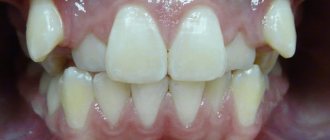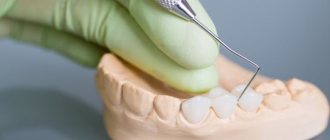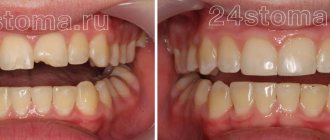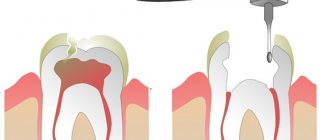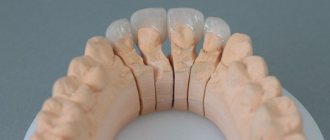Veneers are thin overlays, mainly made of ceramics, that are installed on the front surface of the tooth and the cutting edge. They are used to correct irregular shapes, hide chips and cracks, and eliminate excess gaps. But the most common reason why patients decide to have these miniature dentures installed is the desire to give their teeth a lighter and more even shade. Chemical whitening does not always give the desired effect and requires regular repetition, but veneers solve aesthetic problems comprehensively and for a long time.
How is the color of veneers determined?
To select the color of ceramic microprostheses, dentists use a special scale called Vita. It includes:
- 16 natural shades;
- 4 ultra-whites that practically do not exist in nature - Bleach.
Thus, you can choose the appropriate color from as many as 20 options. If the patient only needs a few restorations, the shade of the veneers should match the color of the adjacent teeth. However, if microprostheses are placed over the entire smile area, then the patient is free to choose any color he likes, based on his ideas about beauty and the doctor’s recommendations.
Naturally colored veneers according to the Vita scale are presented in the form of four blocks in accordance with the enamel undertone:
- A - red-brown;
- B - yellow-red;
- C - gray;
- D - gray-red.
There is no need to be alarmed: such a classification does not mean that the selected sample will be red or gray. Only a specialist will see the difference between the tone of ceramic veneers; for patients, they look approximately the same - like ordinary natural teeth.
Each of the four blocks contains four shades, grouped by brightness: from the lightest to the darkest. They are designated by the numbers 1, 2, 3 and 4. Accordingly, all tooth colors on the Vita scale have their own alphabetic and digital number - for example, a2 or b1.
One shade of composite for central incisors [Clinical case]
Photo 1. – The patient surprised us with a chip of the old restoration of tooth 21 and poorly integrated restorations of teeth 11 and 22.
Which made us think about complex treatment with the replacement of all old restorations.
Since many such emergencies require a quick seal of the dentin and restoration of the tooth, rather than WaxUp, a silicone key, etc. and so on. We decided to restore the tooth with a composite of one shade.
Corrections and improvements can be made to the surface layer of the restoration to make the teeth appear more attractive. But only if necessary (the restoration is often immediately flawless).
Photo 2. – Color selection using the standard Vita scale
is only possible if we make sure that the shades of our material correspond to the shades of the Vita scale. Please note this is not always the case.
The choice of color is made when the teeth are dry. The focus is on healthy tooth tissue. You can also see the old restoration and damaged tissues, which give a dark stain. They do not need to be taken into account when choosing a color.
Photo 3. – Tooth isolation.
The rubber dam must be placed cleanly and perfectly so that it does not interfere with the placement of the matrix and wedge.
Photo 4. – Removal of the old composite restoration.
This is probably the most difficult stage, not only because of the time that needs to be spent. But even due to the concentration of attention, healthy tooth tissue cannot be removed. In this case, we worked with abrasive discs and carbide burs. After removing the restoration, we made a medium thickness bevel. And they polished the entire surface of the tooth.
Photo 5. – Congenital enamel defect
Confirmed that we had removed all the old restoration. This defect was probably the cause of previous restorations.
Photo 6. – We used universal adhesive,
to perform the bonding and dry etching steps simultaneously.
Photo 7. – Extended polymerization of treated teeth.
Photo 8. – Please note that the restoration is multi-layered (i.e. layer-by-layer illumination of the material), but made with one shade.
In this technique, extensions are much more important than color. We don't need to recreate very thin and precise layers. And we can focus on the correct anatomical shape of the restoration.
In this tooth, the proximal walls were recreated, which continued the already existing enamel structure. We will apply the same strategy for tooth 2.1.
Photo 9. – The vestibular surface is built independently and with special care,
to leave the surface as smooth and even as possible. Immediately, a quick finishing of the proximal walls is carried out to create the ideal shape.
Photo 10. – This style of restoration of the proximal walls is impossible using the technique of layer-by-layer multi-color restoration.
But in our case, with a one-color restoration, the thickness and configuration of the walls does not matter.
The palatal wall is formed by a small amount of composite placed on the finger. Note that the operator must angle the finger to simulate the oral concavity of the central incisor. After illuminating the palatal wall (it turned out to be too thick for the classical technique), the proximal walls are formed using sectional matrices. The last step is to build the vestibular wall with the same color.
Photo 11. – Look how inaccurate the restorations turned out.
We knew from the very beginning that the finishing stage would be a little longer than usual.
Photo 12. – Finishing of the restoration.
It is carried out with diamond burs at low speed. Low speed allows for better control of movements and a smooth surface. Even if the diamond grain is too rough. It is worth noting that without this stage, grinding and polishing cannot be flawless.
Photo 13. – The restoration is pre-polished with a brown spiral disc and polishing paste.
Photo 14. – Next we polish with a second spiral disc.
Photo 15. – For additional shine we use polishing felt discs.
Photo 16. – Result after removal of the rubber dam.
No success or failure is assessed at this stage. Since it is not known how the restoration will behave in the future. What is beautiful now can look terrible in a week.
Photo 17. – Surface structure after polishing.
Photo 18. – Check in a month.
Photo 19. – The same thing, only photographed without diffusers.
To evaluate the shine of the restoration.
The most popular colors of ceramic veneers
The standard for a beautiful smile is straight, light teeth that look natural. Aesthetic dentistry helps to achieve exactly this effect, so it is not surprising that the most popular shades on the Vita scale are considered to be the first numbers in tones A and B.
✔
Patients who want natural veneers are most often attracted to color a1 (photo). This is a light pearl shade, close in brightness to the Bleach range, but without artificial whiteness. This color is refreshing and, without exaggeration, rejuvenating, because, as we know, in our youth our teeth look much whiter.
✔
The color of A2 teeth is a little darker, but only a doctor can distinguish such veneers from natural teeth - those around you will be sure that your smile is so naturally beautiful.
✔
Another favorite tooth color for many is b1. It's just as light and bright as a1, but has a different tonality that will be preferable for certain skin tones.
Reasons for changes in enamel color
This article talks about typical ways to solve your issues, but each case is unique! If you want to find out from me how to solve your particular problem, ask your question. It's fast and free
!
Throughout human life, changes in the color of teeth constantly occur. There are many reasons for this:
The darkening of teeth is preceded by incipient pathological processes, which, if left untreated, will lead to disease. These may be jaundice, hemolytic syndromes, when bilirubin accumulates in dentin, damage to the liver and bile ducts, and endocrine diseases. Uncontrolled use of antibiotics, especially tetracyclines, can also lead to darkening of teeth.
Injuries to the maxillofacial apparatus also lead to changes in the shade of teeth. Also, teeth darken from the use of fillings containing metals. Fortunately, dentists are now widely abandoning these materials.
It should be understood that no amount of whitening will help if the cause of the problem is not eliminated first. If the procedure is applied without prior treatment, the consequences will be catastrophic.
Bleach teeth color - Hollywood smile
No matter how much natural beauty is valued, many patients dream of a dazzling white smile, like that of movie stars. For such cases, the Vita palette includes four snow-white shades “Bleach”, which do not exist in nature.
Bleach 1 and Bleach 2 are bright white enamel with virtually no yellow pigment. Such shades are associated with shockingness and can only look good on stage, in the spotlight and against the backdrop of bright makeup. In shades Bleach 3 and Bleach 4 a small percentage of yellow pigment appears, but they still remain outside the natural palette.
The bleach color of ceramic veneers looks more appropriate on dark skin. Those with Northern European appearance are better off giving preference to natural shades a1 and b1 - they are just as light, but look more organic.
What do natural teeth look like?
Innate color depends on:
- genetic factor;
- human habitat;
- skin color, race.
There is a common belief that black people have a white smile. This is a fallacy, an optical illusion. Their smiles appear brighter against dark skin backgrounds. If you compare the jaws of an African American and a Slav, the result is the same. This phenomenon is found in tanned people. If a person lies in the sun for at least an hour, this is enough to transform his smile.
Colors of Emax ceramic veneers
Emax glass-ceramic microprostheses differ from conventional ceramic veneers in their manufacturing technology. Accordingly, for overlays of this type there is a separate color scale - Vita 3D-Master. Here, not two, but three color selection options are used.
- Brightness - from 1 to 5.
- The tonality is L (more yellow) and R (more red).
- Saturation - from M1 to M3.
To determine the shade of the future veneer, the doctor first determines its brightness, moving from the darkest to the lightest, then selects the intensity level M and, lastly, the tonality L or R. The color codes of the Vita 3D-Master palette consist of three symbols - for example, 3M2 .
Tooth structure disorders
During intrauterine development, developing teeth are affected by:
- the amount of important elements entering the child’s body (calcium, phosphorus, magnesium, fluorine, vitamins);
- medications taken (antibiotics, hormones);
- metabolic disorders;
- chronic diseases of organs and systems;
- composition of food products and quality of drinking water;
- hereditary developmental features.
The appearance of white or yellow spots on teeth is characteristic of diseases such as fluorosis and enamel hypoplasia. Even during the formation of teeth, the body is affected by an excess amount of fluoride supplied with water or food (fluorosis develops), or a lack of calcium, necessary for the construction of full-fledged tooth enamel, is affected. Stress, toxicosis, and infections during pregnancy can lead to abnormalities in the structure of the teeth of the unborn child. Exposure to tetracycline antibiotics causes lesions with a permanent change not only in the color of the enamel, but also in its relief - “tetracycline teeth”, which are very difficult to treat. The presence also changes the color of the teeth, because over time, food and plaque dyes easily settle in areas of softened tissue. A special type of oral bacteria can color teeth greenish or brown (chromogenic bacteria), and when there are cracks and erosions on the teeth, good hygiene of these areas is difficult, so they quickly change color and become noticeable even to the patient. Some bacteria can react with metals released from dentures or amalgam fillings (iron, silver, mercury), resulting in unpleasant sensations in the mouth, the taste may change, and the teeth become gray, black, greenish or blue. With an excessive intake of vitamin D into the body, the mineralization of the enamel does not proceed correctly and areas in the form of “belts” form on the teeth, tightening the crown, and with congenital porphyria, the teeth become red-brown.
What color of veneers should I choose?
A doctor will help you find the right shade for your restorations, ideally together with a dental technician.
If it is necessary to restore the aesthetics of individual teeth, the color of the onlays is selected in accordance with the shade of the “neighbors”. Before getting veneers, you may be recommended a whitening procedure to make your teeth 1-2 shades whiter and choose lighter veneers. Using a palette, the doctor determines the color of each restoration separately, since the central incisors, lateral incisors and canines naturally have different colors and degrees of brightness.
If we are talking about installing veneers on all teeth, then certain rules apply for choosing a shade.
Dentist color selection
To select a shade that is as close as possible to natural, a specialist determines the color of the tooth at three points: the incisal-occlusal part of the tooth, the middle and cervical. After all, our teeth have a different shade of surface at the gum and tip. This is influenced by the health of the tooth and gums itself, as well as the thickness of the enamel.
In the process of selecting the color of veneers, the doctor is guided by the following rules:
- The color of the enamel must be determined only in natural (daylight) lighting, and its intensity should be no more than 1500 lux. Failure to comply with this condition may result in an error when determining the brightness of the hue. Today, many clinics have special installations that simulate daylight. They allow you to adjust the light intensity and provide ideal conditions for selecting the desired shade of dentures.
- The interior of the dental office should be designed in light colors, since any bright objects distort color perception and it is much more difficult for the doctor to correctly determine the color of teeth and veneers. This also applies to the dentist’s clothing, accessories and gloves; the flashy color of any detail can negatively affect the final result.
- teeth must be moisturized, since dry enamel reflects light completely differently.
- the environment should be calm and friendly.
Pros and cons of metal-ceramic crowns
Advantages of metal-ceramic crowns
Strength and durability. Metal-ceramic crowns, due to their strong base, have very high wear resistance and resistance to external influences. With proper use, metal-ceramic crowns can last more than 15 years.
High biocompatibility and hypoallergenic. Thanks to the use of non-toxic materials, the risk of developing allergic reactions when using metal-ceramic prosthetics is minimal.
High functionality. The process of manufacturing metal-ceramic dental crowns allows you to completely recreate the functional task of the teeth: chewing and biting.
Resistance to external influences. The ceramic coating is resistant to abrasion and caries. If small chips appear, they can be easily restored without removing the crown.
Aesthetic appearance. Due to the wide palette of colors and shades, which makes it possible to make crowns similar to your own teeth, metal ceramics provide fairly good aesthetics and an attractive smile. The material does not stain and retains its original appearance for a long time.
Disadvantages of metal-ceramic crowns
The need for depulpation. When prosthetic crowns are made from metal-ceramics, in most cases, removal of the nerve, cleaning and filling is inevitable.
The need for tooth grinding. Unlike ceramics, where minimal grinding of the tooth is sufficient for prosthetics, when installing a metal-ceramic crown, it is necessary to remove about 2 mm of your own tissue.
Possible occurrence of chips. The crowns are covered with ceramic, which can chip under excessive mechanical stress. Therefore, metal-ceramic crowns are contraindicated in patients with bruxism.
Possible allergic reactions. Alloys of chromium and cobalt, from which the base for metal-ceramic crowns are often made, can cause individual intolerance and allergies in some patients.
Wear of antagonist teeth. Due to the high strength of the crown material, as a result of their constant contact with the teeth of the opposite row, your own teeth will wear down faster.
The aesthetics are inferior to metal-free crowns. For chewing teeth, metal-ceramic crowns are an excellent solution. But on the front row, the metal base will shine through the ceramics. Therefore, our dentists recommend using ceramic crowns for a more natural and aesthetic appearance for the smile line.
In addition to the above disadvantages, there are a number of contraindications for installing metal-ceramic crowns.
The installation of metal-ceramic crowns is contraindicated in the following cases: - Allergic reaction to metal. - Serious malocclusions. — Periodontal pathology. - Bruxism. — Shortened crown part of the tooth. — Inflammatory diseases of the oral cavity. - Pregnancy. — Acute systemic diseases. — Weakening of the immune system after an illness.
White or natural color?
Everyone knows that veneering is the most painless and effective way to eliminate visible dental damage. With age, teeth are subject to wear and tear, and this affects their appearance. As a result, the functioning of the muscles of the oral cavity is disrupted, and the quality of chewing functions decreases.
The canines and incisors are shortened, which leads to bite deformation. In order to minimize age-related manifestations and the formation of facial wrinkles in the area of the nasolabial triangle, aesthetic dentistry offers veneering. We are talking about adding the missing height and volume to the teeth.
Aesthetics and whiteness do not go unnoticed. Some patients resort to veneering in the hope of whitening their teeth by several shades. But experts recommend observing the measure, since excessive whiteness of some elements will visually emphasize the yellowness of others.
What is a tooth
There are 3 components of a tooth - enamel, dentin, and nerve
- Enamel is the hardest substance in our body, and when it is well mineralized, as it usually is, it is quite white. But there can also be varying levels of translucency in the enamel, causing the dentin to show through.
- Dentin is much softer and contains organic and inorganic components. It is typically yellowish in color, but can range from brown to gray.
- The nerve of the tooth contains nerve and vascular tissue, which provides nutrition to the teeth and all sensations.
Ways to prolong the results of dental correction
After the procedure of dentures, professional whitening, installation of veneers, it is necessary to follow the recommended care measures. Daily sanitation of the oral cavity with rinsing solutions is indicated. It is not recommended to use an electric or ultrasonic brush.
The impact of devices whose working head rotates at high speeds heats up aesthetic overlays or microprostheses, accelerating their destruction. Such brushes provoke peeling of the adhesive organic substance and reduce the service life of the orthopedic structure.
The whitening procedure using the Vita scale thins tooth enamel and increases susceptibility to external irritants. For care, use special pastes with a gentle composition. To preserve the natural color of your teeth, periodic visits to the dentist for professional cleaning are recommended.
Baby teeth in a child and their color
A child’s primary teeth are smaller in size than his permanent teeth, since at the time of their eruption the formation of the jaw has not yet been completed. Another feature of temporary teeth is their thin roots, which dissolve before being replaced by permanent ones. The baby has been using baby teeth for only a few years, so by nature their enamel is thinner than that of molars, and the teeth themselves are white with a slight, subtle bluish tint.
The appearance of spots of any shade on the surface of the tooth - snow-white, black, brown, yellowish - may indicate the development of carious lesions. The earliest sign of caries - demineralization of the enamel - looks like a white spot of a “chalky” shade.
If it is detected, you should immediately contact a pediatric dentist. Then there is a chance to avoid the procedures of preparation, filling or tooth removal that are unpleasant for the child.
Advice from Dr. Zubastik
Don't like the color of your teeth? Don't worry, the problem can be solved. If you wish, you can buy a special set of mouth guards and lightening gel and lighten the enamel at home.
But first, consult your doctor: he may advise you to limit yourself to ultrasonic cleaning. In this case, the teeth will become half a tone whiter.
If it’s not enough, use a professional whitening service or install veneers. The main thing is that in pursuit of beauty, do not forget about dental health. Frequent bleaching weakens the enamel. Maybe it’s better to agree with what nature gave - after all, yellowish enamel is really a little stronger than ideal white?
Do you want to lighten your enamel? Watch how it happens:
Tags: Baby teeth, whitening, Teeth color, Vita scale
About the author: Dr. Zubastik
Typically, a toothache begins to subside on the way to the clinic and finally goes away after 10 minutes of sitting in line to see the dentist.
- Related Posts
- What not to do after tooth extraction: 10 anti-tips
- Is it possible to do an MRI with dental implants?
- We teach children to brush their teeth in the morning and evening on a schedule
« Previous entry
Preventive measures
It is necessary to visit the dentist once every six months, clean the teeth from plaque and deposits, and promptly treat possible diseases.
By following all these simple rules, you can significantly extend the natural shade of tooth enamel.
It is worth noting that with age, people's enamel color changes in any case due to the structural features and porosity of hard tissues. Therefore, it is better to worry about this in advance - visit the dentist and choose an effective whitening method.
In the section on the question Dentistry! Does anyone know the colors of crowns A2 and A3, which is lighter? really, really need to know... asked by the author Zhanna
the best answer is
Lighter - A2, and even lighter than A1, if you really want completely snow-white (the color of baby teeth), then this is B1.
In general, ask any dentist to show you the “Vita” scale, you yourself can determine what suits you best. And don't forget to determine the color in daylight. Good luck to you! Let this help you! INCOGNITO Master (1581) Actually, A3 is a more common color, A2 may look unnatural. It all depends on your natural color. The main thing is that the teeth look natural. In addition to color, you need to take into account shape and transparency. Otherwise, you can make them light and without transparency, then the teeth will look like plumbing fixtures. Or too transparent, in which case the opaque layer will be visible - also not beautiful. My advice to you: don’t go to the fitting alone, so that someone can look from the outside, preferably that someone is a woman between 18 and 25 years old, because about 6% of men do not distinguish minor differences in colors. If you don’t like something, you can insist that the dentist redo everything. Just try to do everything correctly, because the doctor gets very upset when the result of the work is unsatisfactory, as a result, both the doctor and the patient and the work done suffer. Reply from 22 replies
[guru]
Hello! Here is a selection of topics with answers to your question: Dentistry! Does anyone know the colors of crowns A2 and A3, which is lighter? really, really need to know...
The color of teeth is determined by genetics, but throughout life their shade can change depending on various factors. As a rule, not for the better. You can achieve whiter teeth through whitening at the dentist, but not all types of teeth respond well to whitening.

